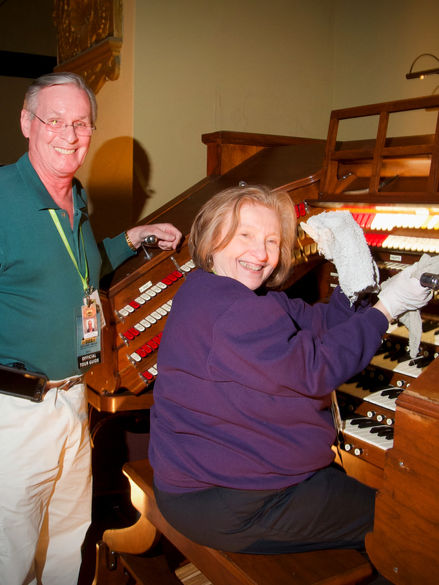About the Kimball
The Painting Next to the Mona Lisa

The History
The W.W. Kimball organ, Opus 7073, of the Adrian Phillips Theater is one of the largest original installations left in a public entertainment venue in the nation. Designed with the accompaniment of motion pictures in mind (all films before 1927 were silent), it is especially good at creating the illusion of a full symphony orchestra as well as producing an incredible array of unique sound effects such as birds, trains, sirens and gongs. All of these sounds are (as with the organ in the main arena) produced by compressed air acting upon organ pipes and orchestral instruments hidden behind the walls of the main stage. There are no electric amplifiers or speakers included.
Recent restoration efforts led by the non-profit Historic Organ Restoration Committee (HORC) have returned approximately 95% of this instrument to operation, and it is now featured for recitals throughout the season in addition to the noon concert series when the main arena is in use.
The Theater is, itself, a room of gigantic size. It is 181 feet long, 128 feet wide, and 75 feet high. It seats 3,000 people (including the rear balcony). The organ is situated in two chambers, one on each side of the stage in the standard arrangement for most theater organs of the era. The console is located in the musicians' balcony (a transposed orchestra pit actually) half way along the inner side of the room about 110 feet from the nearest chamber and about 150 feet from the left chamber (facing the stage).
It was the intention of Mr. Lincoln Dickey, the first manager of the Hall, to use this room as a dance hall and also as a motion picture theater. Therefore, he wanted an organ of orchestral type, or as he viewed it a “theater organ.” Emerson Richards, architect of this instrument (also of the organ in the main hall), was unwilling to design the organ for the limited purpose of accompanying motion pictures (something which sound pictures were soon to displace) and therefore proposed an instrument that was orchestral in character but would likewise have the foundation of a true pipe organ. Therefore, he departed from the usual design of 8 to 15 “units” of orchestral reeds, flutes, strings and diaphones all on high wind pressures and included proper choruses of diapasons, mixtures and reeds in each chamber. These choruses consist of 20 voices never normally found in theater organs. Upon this, Richards added 22 voices of the unit character. The combination proved to be an outstanding success, and an organ of solid but brilliant character resulted.
The instrument was completed in 1930 and dedicated in a recital by organist Rollo Maitland on May 25th of that year.









